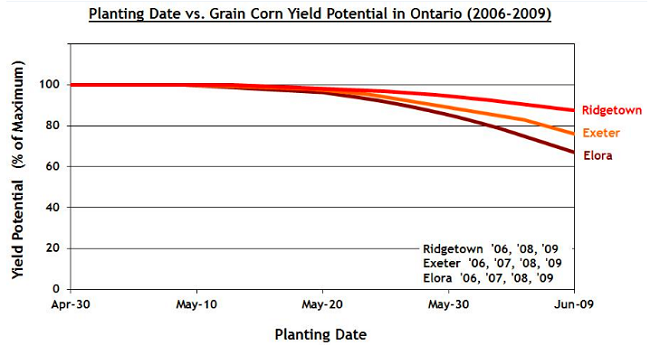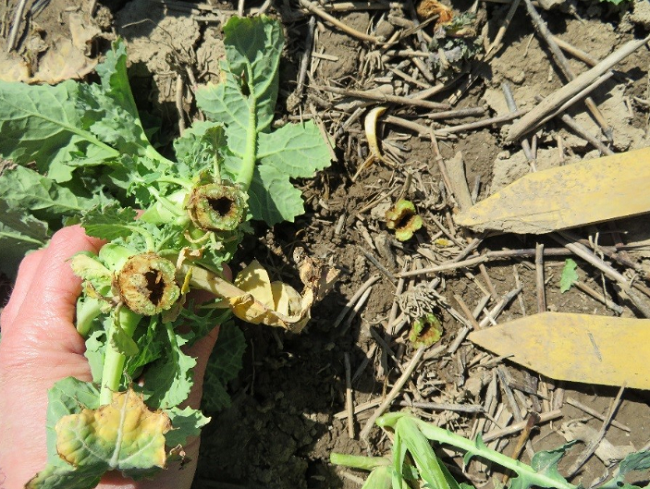Weather
The continuing thread of the story for this spring is the weather. Very little has changed across the province in the last week in terms of manure application, wheat fertilization, tillage and crop planting. We continue to wait on weather that allows fields to dry out and support equipment. Eastern Ontario did get a small window to get some activity happening. Rainfall amounts vary widely but the lack of sunny, warm, windy days is what has been missing and slowing down our journey to the fields.
We also continue to wait for some heat to show more growth on over wintering crops such as alfalfa, wheat and canola. Despite anxiousness about getting the crop planted, the amount of heat we have missed to date is minimal. For this reason, in many ways it’s best that the seed is still in the bag!
Stress
Farmers are feeling it! So is most of the supply chain. This is mental health week. If you come upon clients who you are concerned about, seek help. Resources, including an online chat option, are available. See links at end of report. The Ontario Mental Health Help Line is 1-866-531-2600, or you can dial 211 to be connected to mental health support in your community. We need people looking out for each other. It’s difficult and uncomfortable but we are in this together. Watch out for yourselves and those around you.
Soil Compaction
Everyone is itching to go and feeling caught by the season delay. This will push people into fields earlier than they should be there. You end up living with compaction for a long time. Options are patience, lower tire pressure, use the biggest volume tires you can, don’t fully load manure and fertilizer spreaders etc. Tire pressure has a compaction and safety component. On the road you need to be properly inflated for the speed, load, and distance you travel. But this “road” pressure often contributes to soil compaction.
Observations May 7th saw fields being worked that were obviously too wet. This will impact seed emergence uniformity and the crops ability to access nutrients and water as the season progresses. From the minute the seed goes in the ground, multiple stresses are working against yield potential. Our objectives should be to minimize these stresses to give the crops their best chance to deliver on their potential.

Figure 1. Wheat Ground Differences and Application Equipment Wheel Choices Impact Soil Compaction
Winter Wheat
A bit of heat between Saturday May 4th to Monday May 6th allowed much needed nitrogen to get to some fields. Other fields reacted to the heat and saw some significant green up which is making decisions on those marginal fields easier. It remains difficult on many fields where tire tracks are seen to know if they have been fed nitrogen or glyphosate as its that marginal on some of these fields. The decision to keep fields has many reasons (straw, rotation, contracts). In general, if the yield potential is below 80 bu/ac and you don’t need the straw and you have a good crop rotation history, it’s best to take them out.
When assessing fields its important to look beyond the bare spots and into the rows where the wheat is growing. Are the populations there (7-10 plants per foot), are there missing lengths of row scattered throughout, are the plants well rooted to the soil? This is almost exclusively in late planted fields where these hard decisions are having to be made.
For the marginal fields being kept, thinner stands will be more susceptible to weed growth so scouting will be important for optimal control. Timing will be key on all inputs to optimize the compromised yield potential that is in those fields.

Figure 2. Differences in Wheat Fields Seen Across Ontario
Spring Cereals
Seed may be hard to find since many have prepared themselves to replace lost winter wheat stands with spring cereals, especially where they need the straw and want to maintain the value of their rotation. Very little has been planted to date, so time will tell. Planting deadlines for Agricorp range from April 25th in area A to May 31 in area D (
http://www.agricorp.com/SiteCollectionDocuments/PID-PlantingDates-SpringGandO-en.pdf ). With the late start to the season, there may be some case by case options so connect with Agricorp or your local adjustor.
Forages
This past winter has been especially hard on alfalfa. If you have not checked your hay fields yet this spring it is important to get out there now. Since good planting conditions could arrive on short notice, a plan to address winterkill needs to be developed quickly. Alfalfa over a year old is auto-toxic, so alfalfa should not be re-established or used to patch damaged fields. Stands with mild to moderate winterkill could be patched with grasses or red clover but plan to terminate patched fields in 2020. New stands must be seeded which takes some time if this was not in your plan. Some will take the meagre alfalfa in the first cut and then switch those fields to silage corn or soybeans. Annual forages are a good way to replace lost alfalfa fields, so consider spring cereals, cereal/pea mixtures, Italian ryegrass, or warm-season annuals like sorghum-sudan grass or millet. Many have been relying on cover crop cereal grasses and other mixes after winter wheat but if those acres are down on your operation you need to plan accordingly.
Corn
People get overly anxious on missing planting date windows on corn and essentially no corn is planted across the province as of May 7th. While we acknowledge the importance of planting date in optimizing corn yield potential, the planting date emphasis has always been, when the ground is “fit”! Early planting under “tough” conditions almost never pays off. The one window of planting per season means it has to be as optimal as possible. A poor start to a corn crop compromises its ability to adapt to weather for the remainder of the season. There is a long way to go!

Figure 3. Influence of Planting Date on Corn Yield Potential
We are still way too early in the planting window to be thinking of switching hybrids at this point. Most people are quite realistic with their maturity choices in crop planning these days, so the vast majority need to stay the course for now.
Soybeans
Essentially nothing has happened on soybeans yet. Lots of things to do in wheat, forages, cereals and corn before we worry too much about soybeans. Plans have not changed except that you have to decide if wheat fields removed from the equation are going to corn or soybeans and thus put plans in place respectively.
Canola
Winter canola was planted on approximately 2000 acres last fall, primarily in Essex and Chatham-Kent with some additional fields in Hamilton-Wentworth and North Wellington. Similar to what has been observed with winter wheat, the winter and spring conditions were tough on the canola. Generally, plants on heavier soils showed greater damage than lighter soils. Damage is observed as heaving (plants partially or fully ejected from the soil), necrotic tissue within the center of stems and roots, or hollow stems and roots. Plants that are alive and growing but have large hollow cavities in the taproot likely have low yield potential. Producers should use a knife to cut plants off at the soil surface below the crown to check for hollow taproots. Slight/narrow cavities are not a major concern if most tissue looks healthy. In one field, a high degree of damage was observed in areas with heavy soil but not in areas with lighter soil. Where fields had standing water or excessive moisture, plants simply rotted leaving gaps in the field. That said, many fields in southern regions had great winter survival and have bolted (elongated). These fields should flower any day and may have flowered earlier if conditions had been warmer. Lack of heat has delayed growth significantly in North Wellington, where fields have not yet bolted. Ideally, all nitrogen and sulphur should have been applied by now, ahead of bolting. The wet spring has delayed fertilizer applications in some fields. Producers are remaining positive about the future of winter canola, as this winter/spring seems to have been the worst in 20 years for survival of fall planted crops.

Figure 4. Overwinter Damage to Canola Stems
Source : Field Crop News